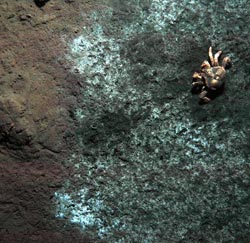Methane seeps of the deep sea: A bacteria feast for lithodid crabs

This is a crab on a bacterial mat at mud volcano Mound 12, documented by a deep-sea observatory.<br><br>Credit: GEOMAR Helmholtz Centre for Ocean Research Kiel<br>
The bottom of the deep sea is largely deserted. Oases occur for example at cold seeps where water transports dissolved elements from the seabed: Specialized microbes convert methane and sulfate from sea water to hydrogen sulfide releasing carbon dioxide.
Highly adapted bacteria, many of which live in symbiosis with worms and clams, use the hydrogen sulfide for their growth. In their cells, they incorporate carbon originating from the chemical reaction of methane. “The co-existence of organisms that have settled at the cold seeps is already well understood”, says Dr. Peter Linke. The biologist at GEOMAR Helmholtz Centre for Ocean Research Kiel is lead author of the publication in the online journal PLOS ONE together with Dr. Helge Niemann from the University of Basel.
“We could give evidence that crabs subsist on the methane seeps. Thus, we came a bit closer to answering the question of which organisms benefit from the cold seeps: Versatile animals living on a mixed diet do so as well. “
In dives with the submersible ALVIN and the underwater robot QUEST off the coast of Costa Rica in the summer of 2005, the researchers observed lithodid crabs grazing at bacterial mats at a methane seep in the vicinity of the mud volcano “Mound 12”. “As far as we know, deep-sea crabs feeding on bacterial mats were discovered only one single time before,” Linke states.
“Our team was the first one to also generate a photographic documentation over a longer period which allows scientific interpretations.” For this purpose, a deep-sea observatory was equipped with a camera and placed above a bacterial mat. During a period of about 400 hours, the camera automatically took a picture every 30 minutes. “On 184 images, crabs were seen crawling over the bacteria and apparently grazed the bacterial “lawn”, Niemann describes the observations. “Afterwards, it took a few hours until the animals returned, so that new bacteria could grow.”
With the submersible ALVIN, the marine biologists brought one of the crabs onboard their research vessel ATLANTIS. For the comparison with the bacteria, the diving robot QUEST took short sediment cores from the sea floor from the METEOR. “DNA and isotopic analyses at Max Planck Institute for Marine Microbiology later showed that the crabs actually feed on the bacterial mat and took up large amounts of chemically-produced carbon. In the body cells, we have also found traces of carbon, which was formed under the influence of light through photosynthesis”, summarizes main author Niemann. “Therefore, we assume that cold seeps make an important but not the only contribution to the diet of migratory animals on the ocean floor and in this way enters into carbon, which is produced by chemosynthesis of methane in the marine food web.”
Original publication: Niemann, H.; Linke, P.; Knittel, K.; MacPherson, E.; Boetius, A.; Brückmann, W.; Larvik, G.; Wallmann, K.; Schacht, U.; Omoregie, E.; Hilton, D.; Brown, K.; Rehder, G.: Methane-carbon flow into the benthic food web at cold seeps – a case study from the Costa Rica subduction zone. http://dx.plos.org/10.1371/journal.pone.0074894
Media Contact
More Information:
http://www.geomar.deAll latest news from the category: Life Sciences and Chemistry
Articles and reports from the Life Sciences and chemistry area deal with applied and basic research into modern biology, chemistry and human medicine.
Valuable information can be found on a range of life sciences fields including bacteriology, biochemistry, bionics, bioinformatics, biophysics, biotechnology, genetics, geobotany, human biology, marine biology, microbiology, molecular biology, cellular biology, zoology, bioinorganic chemistry, microchemistry and environmental chemistry.
Newest articles

Recovering phosphorus from sewage sludge ash
Chemical and heat treatment of sewage sludge can recover phosphorus in a process that could help address the problem of diminishing supplies of phosphorus ores. Valuable supplies of phosphorus could…

Efficient, sustainable and cost-effective hybrid energy storage system for modern power grids
EU project HyFlow: Over three years of research, the consortium of the EU project HyFlow has successfully developed a highly efficient, sustainable, and cost-effective hybrid energy storage system (HESS) that…

After 25 years, researchers uncover genetic cause of rare neurological disease
Some families call it a trial of faith. Others just call it a curse. The progressive neurological disease known as spinocerebellar ataxia 4 (SCA4) is a rare condition, but its…





















